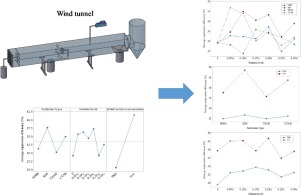当前位置:
X-MOL 学术
›
Colloids Surf. A Physicochem. Eng. Aspects
›
论文详情
Our official English website, www.x-mol.net, welcomes your
feedback! (Note: you will need to create a separate account there.)
Evaluation of the coal dust suppression efficiency of different surfactants: A factorial experiment
Colloids and Surfaces A: Physicochemical and Engineering Aspects ( IF 4.9 ) Pub Date : 2020-06-01 , DOI: 10.1016/j.colsurfa.2020.124686 Ping Chang , Zidong Zhao , Guang Xu , Apurna Ghosh , Jinxin Huang , Tao Yang
Colloids and Surfaces A: Physicochemical and Engineering Aspects ( IF 4.9 ) Pub Date : 2020-06-01 , DOI: 10.1016/j.colsurfa.2020.124686 Ping Chang , Zidong Zhao , Guang Xu , Apurna Ghosh , Jinxin Huang , Tao Yang

|
Abstract Coal dust is a main health hazard in underground coal mines. A recent report showed that a number of coal workers were diagnosed with pneumoconiosis in Australia. Water spray with addition of surfactant has been considered as an effective method to control the coal dust. Numbers of static studies showed surfactant could increase the coal dust wettability effectively. In fact, the contact of coal dust and surfactant droplet is dynamic and more complicated due to the short contact time. Wind tunnel tests are able to present this dynamic process. In this study, a factorial experiment was designed to evaluate the suppression effectiveness for three factors such as (i) different types of surfactants at (ii) different levels of their solutions on (iii) different initial concentrations of coal dust. Four surfactants with seven levels were investigated under two initial coal dust concentrations. The results showed that all the three-factors could affect the suppression efficiency significantly. Surfactants gave higher efficiencies when the initial coal dust concentration was low. Sodium dodecyl sulphate (SDS) and cetyltrimethylammonium bromide (CTAB) performed better than other two surfactants regardless of the initial coal dust concentration. The limitations of this study were also analysed. The results of this study could be used by researches and industry to determine an effective surfactant for coal dust suppression.
中文翻译:

不同表面活性剂抑制煤尘效率的评价:析因实验
摘要 煤尘是煤矿井下主要的健康危害。最近的一份报告显示,澳大利亚有多名煤炭工人被诊断出患有尘肺病。添加表面活性剂的喷水已被认为是控制煤尘的有效方法。大量静态研究表明,表面活性剂能有效提高煤尘的润湿性。事实上,煤尘与表面活性剂液滴的接触是动态的,而且由于接触时间短而更加复杂。风洞试验能够呈现这种动态过程。在这项研究中,设计了一个析因实验来评估三个因素的抑制效果,例如 (i) 不同类型的表面活性剂 (ii) 不同浓度的溶液对 (iii) 不同初始浓度的煤尘。在两种初始煤尘浓度下研究了四种具有七种水平的表面活性剂。结果表明,这三个因素都可以显着影响抑制效率。当初始煤尘浓度低时,表面活性剂具有更高的效率。无论初始煤尘浓度如何,十二烷基硫酸钠 (SDS) 和十六烷基三甲基溴化铵 (CTAB) 的性能都优于其他两种表面活性剂。还分析了本研究的局限性。这项研究的结果可用于研究和工业界,以确定一种有效的煤尘抑制表面活性剂。当初始煤尘浓度低时,表面活性剂具有更高的效率。无论初始煤尘浓度如何,十二烷基硫酸钠 (SDS) 和十六烷基三甲基溴化铵 (CTAB) 的性能都优于其他两种表面活性剂。还分析了本研究的局限性。这项研究的结果可用于研究和工业界,以确定一种有效的煤尘抑制表面活性剂。当初始煤尘浓度低时,表面活性剂具有更高的效率。无论初始煤尘浓度如何,十二烷基硫酸钠 (SDS) 和十六烷基三甲基溴化铵 (CTAB) 的性能都优于其他两种表面活性剂。还分析了本研究的局限性。这项研究的结果可用于研究和工业界,以确定一种有效的煤尘抑制表面活性剂。
更新日期:2020-06-01
中文翻译:

不同表面活性剂抑制煤尘效率的评价:析因实验
摘要 煤尘是煤矿井下主要的健康危害。最近的一份报告显示,澳大利亚有多名煤炭工人被诊断出患有尘肺病。添加表面活性剂的喷水已被认为是控制煤尘的有效方法。大量静态研究表明,表面活性剂能有效提高煤尘的润湿性。事实上,煤尘与表面活性剂液滴的接触是动态的,而且由于接触时间短而更加复杂。风洞试验能够呈现这种动态过程。在这项研究中,设计了一个析因实验来评估三个因素的抑制效果,例如 (i) 不同类型的表面活性剂 (ii) 不同浓度的溶液对 (iii) 不同初始浓度的煤尘。在两种初始煤尘浓度下研究了四种具有七种水平的表面活性剂。结果表明,这三个因素都可以显着影响抑制效率。当初始煤尘浓度低时,表面活性剂具有更高的效率。无论初始煤尘浓度如何,十二烷基硫酸钠 (SDS) 和十六烷基三甲基溴化铵 (CTAB) 的性能都优于其他两种表面活性剂。还分析了本研究的局限性。这项研究的结果可用于研究和工业界,以确定一种有效的煤尘抑制表面活性剂。当初始煤尘浓度低时,表面活性剂具有更高的效率。无论初始煤尘浓度如何,十二烷基硫酸钠 (SDS) 和十六烷基三甲基溴化铵 (CTAB) 的性能都优于其他两种表面活性剂。还分析了本研究的局限性。这项研究的结果可用于研究和工业界,以确定一种有效的煤尘抑制表面活性剂。当初始煤尘浓度低时,表面活性剂具有更高的效率。无论初始煤尘浓度如何,十二烷基硫酸钠 (SDS) 和十六烷基三甲基溴化铵 (CTAB) 的性能都优于其他两种表面活性剂。还分析了本研究的局限性。这项研究的结果可用于研究和工业界,以确定一种有效的煤尘抑制表面活性剂。











































 京公网安备 11010802027423号
京公网安备 11010802027423号